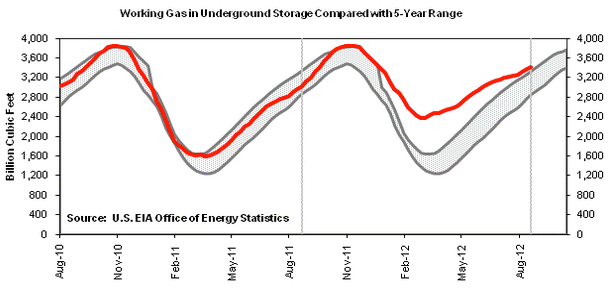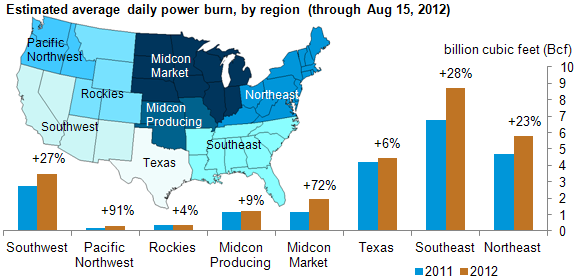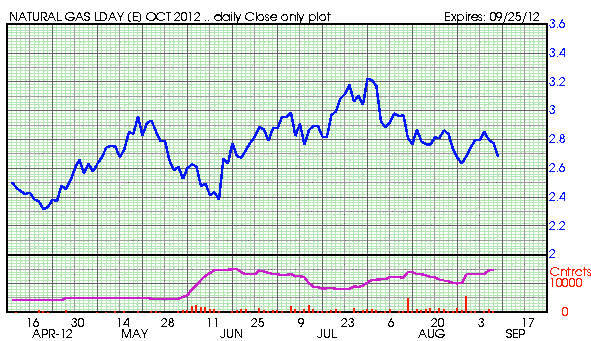It's no surprise this summer resulted in the highest natural gas burn rate on record. Low natural gas prices allowed more substitution by power plants (gas instead of coal) as consistently high temperatures across the U.S. (particularly in the Midwest) drove demand.
According to Bentek Energy, estimated daily natural gas use to produce electric power (also called power burn) averaged 26.3 billion cubic feet per day (Bcf/d) so far in 2012 (Jan 1 - Aug 15), up 24% compared to the same period for 2011. Bentek Energy, which has been estimating power burn since January 2005, said that 17 of the 25 highest days of power burn since 2005 occurred this summer between June 28 and August 9.
Contributing Factors
The two main drivers of the increased use of natural gas at power plants this year are weather and a structural shift toward generating more electricity from natural gas-fired power plants.
This brought the U.S. natural gas inventories, which were unusually high due to the warm winter and high production levels, closer to normal levels for this time of the year.
Drought Driven
Here is the breakdown of where in the U.S. the burn rate was the highest. Not surprisingly it roughly follows the drought pattern (the map shows usage relative to historical patterns).
In spite of the heavy usage, natural gas prices remain subdued.
- English (UK)
- English (India)
- English (Canada)
- English (Australia)
- English (South Africa)
- English (Philippines)
- English (Nigeria)
- Deutsch
- Español (España)
- Español (México)
- Français
- Italiano
- Nederlands
- Português (Portugal)
- Polski
- Português (Brasil)
- Русский
- Türkçe
- العربية
- Ελληνικά
- Svenska
- Suomi
- עברית
- 日本語
- 한국어
- 简体中文
- 繁體中文
- Bahasa Indonesia
- Bahasa Melayu
- ไทย
- Tiếng Việt
- हिंदी
Summer's Gas Burn Rate Breaks Record
Published 09/10/2012, 01:41 PM
Updated 07/09/2023, 06:31 AM
Summer's Gas Burn Rate Breaks Record
Latest comments
Loading next article…
Install Our App
Risk Disclosure: Trading in financial instruments and/or cryptocurrencies involves high risks including the risk of losing some, or all, of your investment amount, and may not be suitable for all investors. Prices of cryptocurrencies are extremely volatile and may be affected by external factors such as financial, regulatory or political events. Trading on margin increases the financial risks.
Before deciding to trade in financial instrument or cryptocurrencies you should be fully informed of the risks and costs associated with trading the financial markets, carefully consider your investment objectives, level of experience, and risk appetite, and seek professional advice where needed.
Fusion Media would like to remind you that the data contained in this website is not necessarily real-time nor accurate. The data and prices on the website are not necessarily provided by any market or exchange, but may be provided by market makers, and so prices may not be accurate and may differ from the actual price at any given market, meaning prices are indicative and not appropriate for trading purposes. Fusion Media and any provider of the data contained in this website will not accept liability for any loss or damage as a result of your trading, or your reliance on the information contained within this website.
It is prohibited to use, store, reproduce, display, modify, transmit or distribute the data contained in this website without the explicit prior written permission of Fusion Media and/or the data provider. All intellectual property rights are reserved by the providers and/or the exchange providing the data contained in this website.
Fusion Media may be compensated by the advertisers that appear on the website, based on your interaction with the advertisements or advertisers.
Before deciding to trade in financial instrument or cryptocurrencies you should be fully informed of the risks and costs associated with trading the financial markets, carefully consider your investment objectives, level of experience, and risk appetite, and seek professional advice where needed.
Fusion Media would like to remind you that the data contained in this website is not necessarily real-time nor accurate. The data and prices on the website are not necessarily provided by any market or exchange, but may be provided by market makers, and so prices may not be accurate and may differ from the actual price at any given market, meaning prices are indicative and not appropriate for trading purposes. Fusion Media and any provider of the data contained in this website will not accept liability for any loss or damage as a result of your trading, or your reliance on the information contained within this website.
It is prohibited to use, store, reproduce, display, modify, transmit or distribute the data contained in this website without the explicit prior written permission of Fusion Media and/or the data provider. All intellectual property rights are reserved by the providers and/or the exchange providing the data contained in this website.
Fusion Media may be compensated by the advertisers that appear on the website, based on your interaction with the advertisements or advertisers.
© 2007-2025 - Fusion Media Limited. All Rights Reserved.
